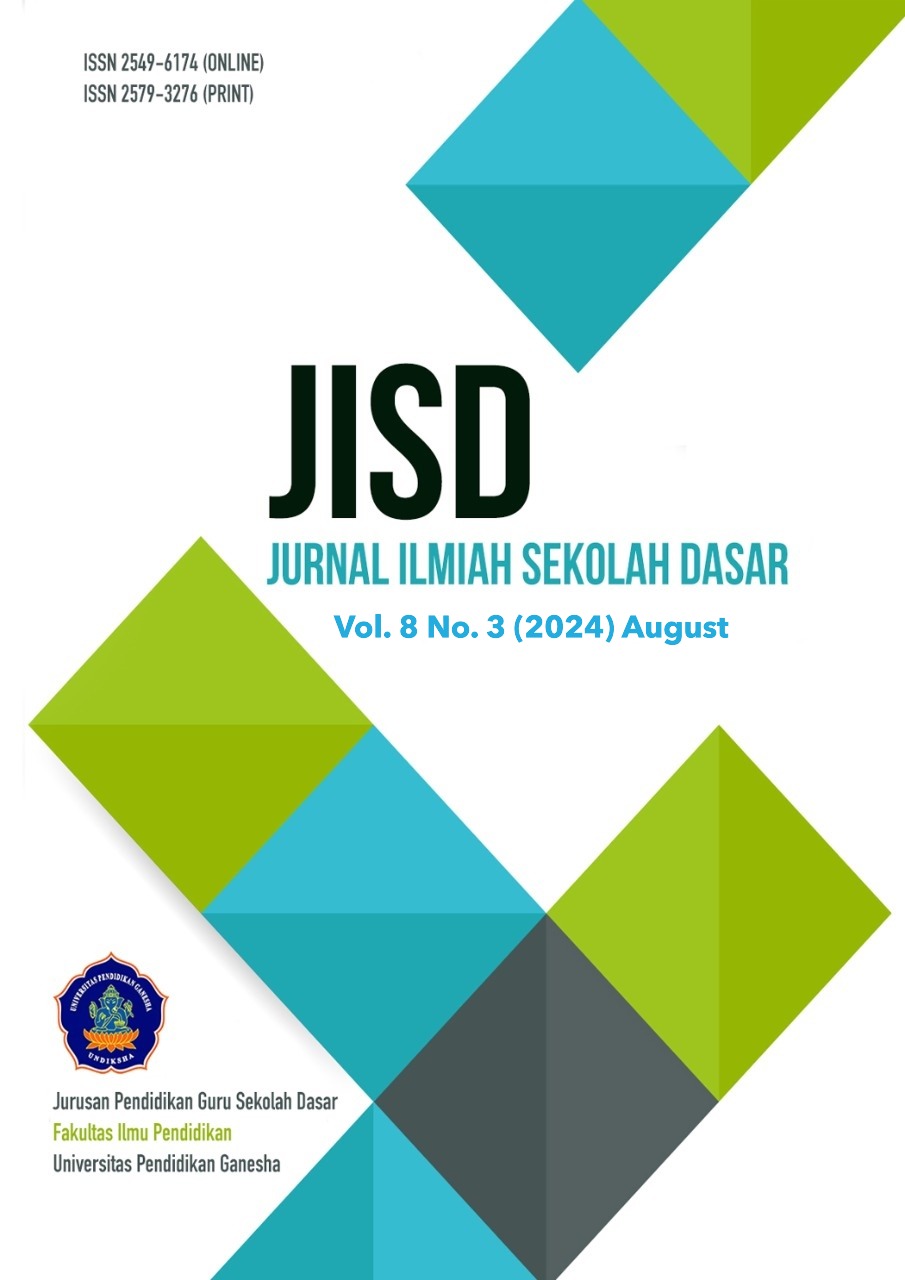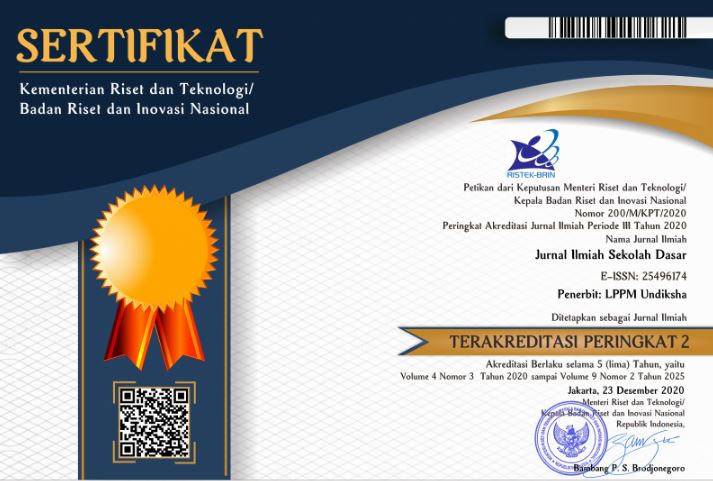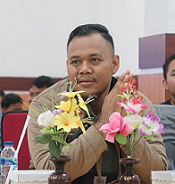Enhancing Prospective Elementary School Teachers' 4C Skills: Instrument Development in the Context of Materials and Changes Lecture
DOI:
https://doi.org/10.23887/jisd.v8i3.81105Keywords:
4C Skills, Instrument Development, Reliability, SmartPLS, ValidityAbstract
This research is driven by the urgent need to ensure that prospective elementary school teachers possess adequate 4C skills (Communication, Collaboration, Critical Thinking, and Creativity) to meet the challenges of 21st-century education, particularly in the context of materials and changes lectures. The purpose of this study was to develop and validate a 4C skills instrument for prospective elementary school teachers in lectures on the topic of matter and its changes. The approach used was quantitative with a survey design involving 400 elementary school teacher education students in Indonesia. The sample selection was based on simple random sampling technique. Findings from the PLS-SEM analysis of the measurement model showed that the convergent validity test value through factor loading for communication skills (CMC), collaboration (CLB), critical thinking (CTC), creativity (CTV), and lecturer assignments (C) showed values greater than 0.6 and and the Average Variance Extracted (AVE) value showed values greater than 0.5. The Reliability test value through the composite Reliability (CR) value for each variable shows a value greater than 0.7 and the Cronbach's Alpha value shows a value greater than 0.6. Based on this value, the instrument is declared valid and reliable so that the instrument can be used.
References
Alismail, A. (2023). Teachers’ perspectives of utilizing distance learning to support 21st century skill attainment for K-3 elementary students during the COVID-19 pandemic era. Heliyon, 9(9), e19275. https://doi.org/10.1016/j.heliyon.2023.e19275.
Bartlett, J., Kotrlik, J. W., & Higgins, C. C. (2001). Determing appropriate sample size in survey research. Information Technology, Learning, and Performance Journal, 19(1), 43–50.
https://banglajol.info/index.php/JBAU/article/view/74547.
Basaria, D., Zamralita, & Aryani, F. X. (2021). Peran Perfeksionisme Terhadap Prokrastinasi Akademik Pada Remaja di DKI Jakarta. Jurnal Psibernetika, 14(1), 32–39. https://doi.org/10.30813/psibernetika.v.
Bialik, M., Martin, J., Mayo, M., & Trilling, B. (2016). Evolving Assessments for a 21st Century Education. In Assessment Research Consortium.
Bray, D. A., Girvan, D. C., & Chorcora, E. N. (2023). Students’ perceptions of pedagogy for 21st century learning instrument (S-POP-21): Concept, validation, and initial results. Thinking Skills and Creativity, 49(May 2022), 101319. https://doi.org/10.1016/j.tsc.2023.101319.
Chen, S., & Zhang, B. (2019). Improving Prospective Teachers’ Lesson Planning Knowledge and Skills through Lesson Study. 549–575. https://doi.org/10.1007/978-3-030-04031-4_27.
Chin. (1998). Chin1998. In MIS Quaterly (Vol. 22, Issue 1, pp. vii–xvi).
Creswell, J. W. (2012). Educational Research. University of Nebraska.
Danks, N. P., Sharma, P. N., & Sarstedt, M. (2020). Model selection uncertainty and multimodel inference in partial least squares structural equation modeling (PLS-SEM. Journal of Business Research, 113, 13–24. https://doi.org/10.1016/j.jbusres.2020.03.019.
Erdoğan, V. (2019). Integration of 4C competencies in online mathematics learning in junior high schools during the covid-19 pandemic. International Journal of Education and Research, 7(11), 113–124. https://doi.org/10.1088/1742-6596/1918/4/042083.
Fitriati, F., Rosli, R., Iksan, Z., & Hidayat, A. (2023). Exploring challenges in preparing prospective teachers for teaching 4C skills in mathematics classroom: A school-university partnership perspectives. Cogent Education, 11(1). https://doi.org/10.1080/2331186X.2023.2286812.
Fornell, C., & Larcker, D. F. (1981). Evaluating structural equation models with unobservable variables and measurement error. Journal of Marketing Research, 18(1), 39–50.
https://doi.org/10.2307/3151312.
Gefen, D., Straub, D. W., Boudreau, M.-C., Gefen, D., Straub, D. W., & Boudreau, M. (2000). Structural Equation Modeling and Regression: Guidelines for Research Practice. Communications of the association for information systems, 4(1), 7. Communications of the Association for Information Systems, 4(1), 7. http://www.janrecker.com/quantitative-research-in-information-systems/.
Gold, A. H., Malhotra, A., & Segars, A. . (2001). Knowledge management: An organizational capabilities perspective. Journal of Management Information Systems, 34(5), 688–698.
https://doi.org/10.1002/ceat.201000522.
Griffin, P., & Care, E. (2015). Assessment and Teaching of 21st Century Skills. In Assessment and Teaching of 21st Century Skills. https://doi.org/10.1007/978-94-017-9395-7.
Hair, J. J. F., Hult, G. T. M., Ringle, M., & Sarstedt, M. (2017). A primer on partial least squares structural equation modeling (PLS-SEM (2nd ed.). Sage Publication.
Henseler, J., Ringle, C. M., & Sarstedt, M. (2015). A new criterion for assessing discriminant validity in variance-based structural equation modeling. Journal of the Academy of Marketing Science, 43(1), 115–135. https://doi.org/10.1007/s11747-014-0403-8.
Hidayatullah, Z., Wilujeng, I., Nurhasanah, N., Gusemanto, T. G., & Makhrus, M. (2021). Synthesis of the 21st Century Skills (4C) Based Physics Education Research In Indonesia. JIPF (Jurnal Ilmu Pendidikan Fisika), 6(1), 88. https://doi.org/10.26737/jipf.v6i1.1889.
Hulland. (1999). Use Of Partial Least Squares (PLS) In Strategic Management Research: A Review Of Four Recent Studies. Strategic Management Journal, 20, 195–204. https://doi.org/10.1038/aps.2012.31.
Khahro, S. H., & Javed, Y. (2022). Key Challenges in 21st Century Learning: A Way Forward towards Sustainable Higher Educational Institutions. Sustainability (Switzerland), 14(23).
https://doi.org/10.3390/su142316080.
Koh, K., Delanoy, N., Bene, R., Thomas, C., Danysk, G., Hone, G., Turner, J., & Chapman, O. (2019). The Role of Authentic Assessment Tasks in Problem-Based Learning. Postsecondary Learning and Teaching, 3, 17–24. https://doi.org/10.11575/pplt.v3i1.53144.
Laar, E. V, Deursen, A. J. A. M. V, Dijk, J. A. G. ., & Haan, J. D. (2020). Determinants of 21st-century skills and 21st-century digital skills for workers: A systematic literature review. SAGE Journal, 10(1), 1–14. https://doi.org/10.1177/2158244019900176.
Mardhotillah, N. I., & Yulhendri. (2022). Confirmatory factor analysis (cfa) interaksi dosen-mahasiswa dalam pembelajaran daring. Jurnal Salingka Nagari, 1(1), 93–100.
https://doi.org/10.24036/jsn.v1i1.13.
Maulana, Y., & Sopandi, W. (2022). Needs Analysis of Electronic Student Worksheets to Practice 4C Skills. Jurnal Basicedu, 6(1), 602–611. https://www.academia.edu/download/83513644/pdf.pdf.
Maulana, Y., Wijayanti, I. E., & Solfarina, S. (2021). Development Electronic Student Worksheet based on Relating, Experiencing, Applying, Cooperating, and Transferring (REACT) in Introduction to Chemistry and Laboratory. JTK (Jurnal Tadris Kimiya), 6(2), 213–222.
https://doi.org/10.15575/jtk.v6i2.14988.
Molla, A., Yayeh, M., & Bisaw, A. (2023). The current status of faculty members’ pedagogical competence in developing 21st century skills at selected universities in Ethiopia. Cogent Education, 10(2). https://doi.org/10.1080/2331186X.2023.2228995.
Nahar, S., Suhendri, Zailani, & Hardivizon. (2022). Improving Students’ Collaboration Thinking Skill under the Implementation of the Quantum Teaching Model. International Journal of Instruction, 15(3), 451–464. https://doi.org/10.29333/iji.2022.15325a.
Rodrigues, de S., Henrique, P., Reyes Junior, E., & del Corte Lora, V. (2024). Development, validation, and reliability of a measurement scale for investigating the principle of intercooperation. Annals of Public and Cooperative Economics, 95(2), 553–572. https://doi.org/10.1111/apce.12426.
Sarstedt, M., Ringle, C. M., & Hair, J. F. (2020). Handbook of Market Research. In Handbook of Market Research (Issue July). https://doi.org/10.1007/978-3-319-05542-8.
Sunardi, S., & Doringin, F. (2020). The 4Cs Learning Model in Teacher Professional Development Program. Humaniora, 11(2), 151–157. https://doi.org/10.21512/humaniora.v11i2.6508.
Trisnawati, W. W., & Sari, A. K. (2019). Integrasi Keterampilan Abad 21 Dalam Modul Sociolinguistics: Keterampilan 4C (Collaboration, Communication, Critical Thinking, Dan Creativity). Jurnal Muara Pendidikan, 4(2), 455–466. https://doi.org/10.52060/mp.v4i2.179.
Urbach, F., Nils, & Ahlemann. (2010). Structural Equation Modeling in Information Systems Research Using Partial Least Squares. Journal of Information Technology Theory and Application (JITTA), 11(2), 5–40. https://repository.vlerick.com/handle/20.500.12127/6453.
Vinzi, V. E., Chin, W. W., Jörg, H., & Wang, H. (2010). PLS in Data Mining and Data Integration. In Handbook of Partial Least Squares. https://doi.org/10.1007/978-3-540-32827-8_16.
Widodo, S., & Wardani, R. K. (2020). Mengajarkan Keterampilan Abad 21 4C (Communication, Collaboration, Critical Thinking And Problem Solving, Creativity And Innovation) Di Sekolah Dasar. MODELING: Jurnal Program Studi PGMI, 7(2), 185–197. https://doi.org/10.36835/modeling.v7i2.665.
Zhang, S., Du, J., Yue, H., Li, G., & Zhang, D. (2023). Study on the National Identity Education Intentions of Pre-Service Teachers: Evidence from PLS-SEM and fsQCA. Sustainability (Switzerland), 15(16). https://doi.org/10.3390/su151612633.
Zubaidah, S. (2018). Mengenal 4C: Learning and Innovation Skills untuk Menghadapi Era Revolusi Industri 4.0. 2nd Science Education National Conference, 2(2), 1–18.
https://www.researchgate.net/profile/siti-zubaidah-7/publication/318013627.
Downloads
Published
How to Cite
Issue
Section
License
Copyright (c) 2024 Yusup Maulana, Wahyu Sopandi, Rahmat Iqbal, Maryos Ipaubla

This work is licensed under a Creative Commons Attribution-ShareAlike 4.0 International License.
Authors who publish with the Journal Ilmiah Sekolah Dasar agree to the following terms:
- Authors retain copyright and grant the journal the right of first publication with the work simultaneously licensed under a Creative Commons Attribution License (CC BY-SA 4.0) that allows others to share the work with an acknowledgment of the work's authorship and initial publication in this journal.
- Authors are able to enter into separate, additional contractual arrangements for the non-exclusive distribution of the journal's published version of the work (e.g., post it to an institutional repository or publish it in a book), with an acknowledgment of its initial publication in this journal.
- Authors are permitted and encouraged to post their work online (e.g., in institutional repositories or on their website) prior to and during the submission process, as it can lead to productive exchanges, as well as earlier and greater citation of published work. (See The Effect of Open Access)










